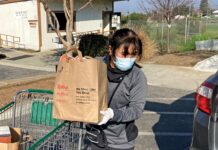Q:
What San Benito County girl beat Will Rogers in roping?
A:
Last month I wrote about how the famous cowboy movie star Will
Rogers use to make frequent visits to the Quien Sabe Ranch near the
San Benito County village of Tres Pinos.
Q:
What San Benito County girl beat Will Rogers in roping?
A:
Last month I wrote about how the famous cowboy movie star Will Rogers use to make frequent visits to the Quien Sabe Ranch near the San Benito County village of Tres Pinos. In his newspaper column May 17, 1934, Rogers wrote he had been branding cattle at the ranch. “Didn’t mind all the men beating me roping, but when a girl did, it looks like golf will be coming up pretty soon,” he told readers.
Thanks to Elma Barber of Hollister, I soon learned that the girl’s name was Lola Fruits, Barber’s aunt. She later married a a cowboy named Frank Galli and, as Lola Galli, became a prominent member of South Valley. Lola worked with Frank for many years running Quien Sabe.
Starting at age 16 at the 1923 Salinas Rodeo, Lola began professionally showing horses. Over more than 50 years, she won many trophies and honors for her excellent riding ability. “She loved horses,” Barber told me. “That was her life. She was a magnificent rider. Any old timer would tell you that she was the best.”
In Marjorie Pierce’s book “East of the Gabilans,” Lola is quoted describing how she and Frank first met Rogers at the Salinas Rodeo:
“He came to the ring one morning at Salinas while we were working the stock. Later, he came to see us several times at Quien Sabe. One time he came for a branding. Frank gave him a good horse and told him he would have to dally (take turns). This is what Will wanted – to be just like the rest. He didn’t want a fuss made over him.”
Rogers had planned to return to Quien Sabe Ranch before taking an Alaska flying adventure with aviation pioneer Wiley Post. Unfortunately, he never got the opportunity to make it back to San Benito County. He died on Aug. 15, 1935 when the airplane he and Post were in crashed near Point Barrow, Ala.
Q:
How did William Hanna help build the South Valley?
A:
Hanna Street in Gilroy is named after the pioneer who played an important role during the early years of the city. He arrived in the village on Jan. 1, 1860 to join three of his brothers who already lived in the little community. Seven years later, he bought a redwood lumber mill located just west of what is now Church Street in Gilroy. The mill used wood cut from the nearby Santa Cruz Mountains.
Hanna’s enterprise proved successful and provided much of the lumber that went into building the homes and business of Gilroy, Hollister, Tres Pinos and San Juan Bautista. Three years after taking over the mill, he expanded his business by constructing on downtown Gilroy a three-story, 55-room inn called the American Hotel. Later, the name was changed to Hanna House. It served for many years as a social center for the town.
In 1874, Hanna constructed for Gilroy an Opera House music hall that would seat 700 people. Located on Fifth Street between Eigleberry and Monterey streets, it served for more than five decades as a place for local citizens to enjoy cultural performances, academic lectures and social dances.
Hanna died on Oct. 10, 1894. Many of his descendants still live in the South Valley.
Q:
How did Morgan Hill’s Villa Mira Monte House get its name?
A:
Located on Monterey Road a few blocks north of downtown Morgan Hill, Villa Mira Monte originally belonged to Hiram Morgan and Diana Murphy Hill. It was designed in a Queen Anne and Eastlake/Stick style.
The Hill couple used the home as a getaway retreat in the country, traveling to it by train from their estate in San Francisco.
The name Villa Mira Monte refers to the fact that the home looks toward the mountain El Toro – called Murphy’s Peak back in the Hill’s time. No doubt, the Hills and their guests would often sit on the villa’s front porch and enjoys the view of the prominent mountain to the west.The couple sold the house around 1912. It served for many years as a private home.
Later, it functioned as a funeral parlor and an antique store. In 1992, it was donated to the Morgan Hill Historical Society which did considerable repairs to the building to bring it back to its original glory. It opened to the public in 1998.
The Villa Mira Monte house and museum shop are open for tours on Fridays from 1 to 3 p.m. and on Saturdays from 10 a.m. to 1 p.m.












